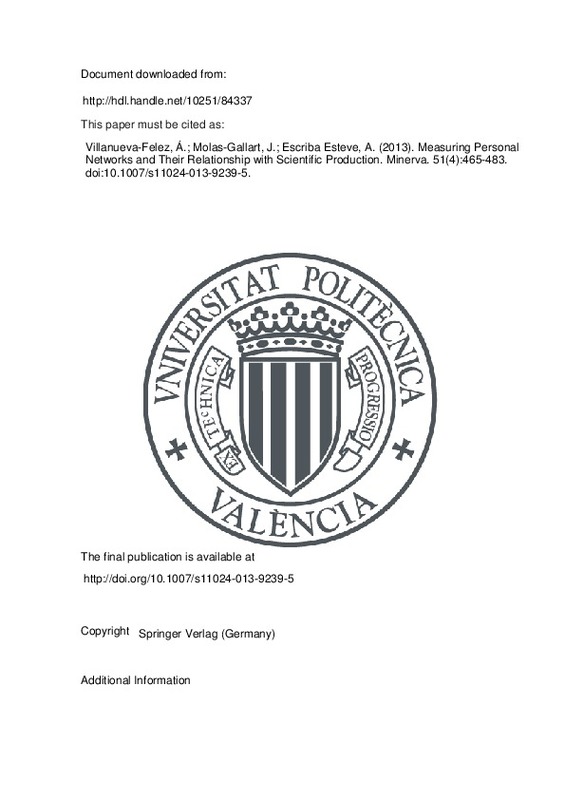Abramo, Giovanni, Ciriaco D’Angelo, and Flavia Di Costa. 2009. Research collaboration and productivity: Is there correlation? Higher Education 57: 155–171.
Adams, Bert N. 1967. Interaction theory and the social network. Sociometry 30(1): 64–78.
Allen, James, Andrew D. James, and Phil Gamlen. 2007. Formal versus informal knowledge networks in R&D: A case study using social network analysis. R&D Management 37(3): 179–196.
[+]
Abramo, Giovanni, Ciriaco D’Angelo, and Flavia Di Costa. 2009. Research collaboration and productivity: Is there correlation? Higher Education 57: 155–171.
Adams, Bert N. 1967. Interaction theory and the social network. Sociometry 30(1): 64–78.
Allen, James, Andrew D. James, and Phil Gamlen. 2007. Formal versus informal knowledge networks in R&D: A case study using social network analysis. R&D Management 37(3): 179–196.
Boorman, B. 1975. A combinational optimization model for transmission of job information through contact networks. Bell Journal of Economics 6(1): 216–249.
Brass, Daniel J., Kenneth D. Butterfield, and Bruce C. Skaggs. 1998. Relationships and unethical behavior: A social network perspective. Academy of Management. The Academy of Management Review 23(1): 14–31.
Burt, Ronald S. 1992. Structural holes: The social structure of competition. Cambridge: Harvard University Press.
Burt, Ronald S. 1997. The contingent value of social capital. Administrative Science Quarterly 42(2): 339–365.
Escribá-Esteve, Alejandro. 2002. Procesos de generación de confianza en los acuerdos de cooperación. Cuadernos de Economía y Dirección de la Empresa 13: 469–497.
Etzkowitz, Henry. 2000. Athena unbound: The advancement of women in science. Port Chester, NY, USA: Cambridge University Press.
Etzkowitz, Henry, and Loet Leydesdorff. 2000. The dynamics of innovation: From national systems and “Mode 2” to a triple helix of university–industry–government relations. Research Policy 29(2): 109–123.
Gnyawali, Devi R., and Ravindranath Madhavan. 2001. Cooperative networks and competitive dynamics: A structural embeddedness perspective. Academy of Management. The Academy of Management Review 26(3): 431–445.
Granovetter, Mark. 1973. The strength of weak ties. American Journal of Sociology 78(6): 1360–1380.
Granovetter, Mark. 1985. Economic action and social structure: The problem of embeddedness. American Journal of Sociology 91(3): 481–510.
Gulati, Ranjay. 1998. Alliances and networks. Strategic Management Journal (1986–1998) 19(4): 293–317.
Gulbrandsen, Magnus, and Jens-Christian Smeby. 2005. Industry funding and university professors’ research performance. Research Policy 34(6): 932–950.
Hair, Joseph F., Rolph E. Anderson, Ronald L. Tatham, and William C. Black. 1998. Multivariate Data Analysis, 5th ed. Upper Saddle River, NJ, USA: Prentice-Hall International Inc.
Heracleous, Loizos, and John Murry. 2001. Networks, interlocking directors and strategy: Toward a theoretical framework. Asia Pacific Journal of Management 18(2): 137–160.
Ibarra, Herminia. 1993. Network centrality, power, and innovation involvement: Determinants of technical and administrative roles. Academy of Management Journal 36(3): 471–501.
Kitagawa, Fumi. 2010. Pooling resources for excellence and relevance: An evolution of universities as multi-scalar network organisations. Minerva 48(2): 169–187. doi: 10.1007/s11024-010-9147-x .
Krackhardt, D. 1992. The strength of strong ties: The importance of philos in organizations. In Networks and organizations, eds. Nitin Nohria, and Robert G. Eccles, 216–239. Boston: Harvard Business School Press.
Lowrie, A., and P.J. McKnight. 2004. Academic research networks: A key to enhancing scholarly standing. European Management Journal 22(4): 345–360.
Mayer, Roger C., James H. Davis, and F. David Schoorman. 1995. An integration model of organizational trust. Academy of Management. The Academy of Management Review 20(3): 709–734.
McEvily, Bill, and Akbar Zaheer. 1999. Bridging ties: A source of firm heterogeneity in competitive capabilities. Strategic Management Journal 20(12): 1133–1156.
Meyer, Martin, Piera Morlacchi, Olle Persson, Eric Archambault, and Ineke Malsch. 2004. Continuous professional development in emerging technology sectors. In A SPRU Report for the Engineering and Technology Board: SPRU—University of Sussex.
Molas-Gallart, Jordi, P. Tang, and S. Morrow. 2000. Assessing the non-academic impact of grant-funded socio-economic research: Research from a pilot study. Research Evaluation 9(3): 171–182.
Nohria, Nitin. 1992. Is a network perspective a useful way of studying organizations? In Networks and organizations, eds. Nitin Nohria, and Robert G. Eccles, 1–22. Boston: Harvard Business School Press.
Reagans, Ray, and Ezra W. Zuckerman. 2001. Networks, diversity, and productivity: The social capital of corporate R&D teams. Organization Science 12(4): 502–517.
Rigby, J., and J. Edler. 2005. Peering inside research networks: Some observations on the effect of the intensity of collaboration on the variability of research quality. Research Policy 34(6): 784–794.
Rowley, Tim J., D. Behrens, and D. Krackhardt. 2000. Redundant governance structures: Analysis of structural and relational embeddedness in the steel and semiconductor industries. Strategic Management Journal 21(3): 369–386.
Ruef, Martin. 2002. Strong ties, weak ties and islands: Structural and cultural predictors of organizational innovation. Industrial and Corporate Change 11(3): 427–449.
Shannon, Claude E., and Warren Weaver. 1959. The mathematical theory of communication [1949]. Urbana, IL: University of Illinois Press.
Uzzi, Brian. 1996. The sources and consequences of embeddedness for the economic performance of organizations: The network effect. American Sociological Review 61(4): 674–698.
Uzzi, Brian. 1997. Social structure and competition in interfirm networks: The paradox of embeddedness. Administrative Science Quarterly 42(1): 35–67.
Uzzi, Brian, and James J. Gillespie. 2002. Knowledge spillover in corporate financing networks: Embeddedness and the firm’s debt performance. Strategic Management Journal 23(7): 595.
Villanueva-Felez, Africa. 2011. El acceso a recursos desde una perspectiva relacional: Un análisis contingente de las características de los vínculos sociales. Dissertation, Universidad de Valencia, Valencia.
Whittington, Kjersten Bunker, and Laurel Smith-Doerr. 2008. Women inventors in context: Disparities in patenting across academia and industry. Gender Society 22(2): 194–218. doi: 10.1177/0891243207313928 .
Yamagishi, Toshio, Mary R. Gillmore, and Karen S. Cook. 1988. Network connections and the distribution of power in exchange networks. The American Journal of Sociology 93(4): 833–851.
[-]







![[Cerrado]](/themes/UPV/images/candado.png)


